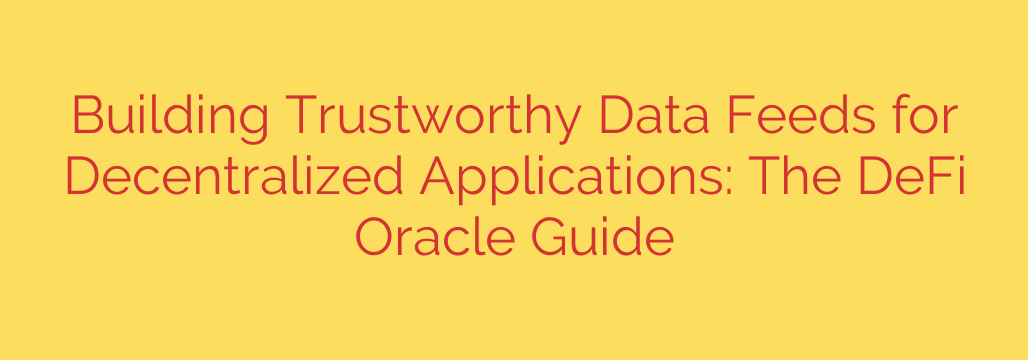
Understanding DeFi Oracles: The Key to Secure and Reliable dApps
Decentralized Finance (DeFi) has unlocked a world of financial innovation, from lending and borrowing platforms to complex derivatives markets, all running on transparent and automated smart contracts. However, these powerful smart contracts have a fundamental limitation: they are isolated from the outside world. To function, they need a secure and reliable way to access real-world data, and this is where oracles come in.
Oracles are the critical infrastructure that connects blockchains to off-chain data, and their importance cannot be overstated. The security and reliability of an entire DeFi application often rest on the quality of its oracle data feeds.
Why Smart Contracts Need a Window to the World: The Oracle Problem
Blockchains are designed to be deterministic and self-contained systems. This means that every node on the network must be able to reach the same result given the same set of inputs. If smart contracts could freely pull data from any external website or API, this consensus would break. Different nodes might get slightly different data at different times, leading to a complete breakdown of the blockchain’s integrity.
This creates the “Oracle Problem”: how do you feed essential, real-world data to a system that is intentionally cut off from the real world?
A lending protocol, for example, needs to know the current price of Ethereum (ETH) to determine if a borrower’s collateral is sufficient. A decentralized insurance platform needs weather data to verify a claim for crop damage. Without a secure data source, these applications simply cannot operate.
What Are DeFi Oracles? The Bridge Between On-Chain and Off-Chain Worlds
An oracle is not a data source itself. Instead, oracles act as a secure bridge, fetching, verifying, and delivering external information to a smart contract in a way that the blockchain can trust. Think of them as middleware that translates real-world information into a language that blockchains can understand and use to execute smart contracts.
A flawed or manipulated oracle feed can lead to catastrophic financial losses for users. Therefore, building or choosing a trustworthy oracle is one of the most critical security decisions for any dApp developer.
The Anatomy of a Trustworthy Oracle: Key Components for Security
Not all oracles are created equal. A robust and secure oracle solution is built on several key principles designed to eliminate single points of failure and prevent data manipulation.
Data Source Integrity: A reliable oracle doesn’t just pull data from a single source. A truly trustworthy oracle aggregates data from numerous high-quality, reputable data aggregators, ensuring that the final price point is a volume-weighted average from across the entire market. This prevents a single faulty or manipulated exchange from compromising the entire feed.
Decentralized Network: Using a single, centralized oracle node reintroduces the very problem blockchains are meant to solve. If that one node is hacked, corrupted, or simply goes offline, the entire dApp fails. Using a decentralized network of independent, geographically distributed nodes prevents any single entity from manipulating the data feed.
Cryptoeconomic Security: To ensure nodes behave honestly, robust oracle networks employ a system of rewards and penalties. Nodes are often required to stake collateral (such as the network’s native token), which can be slashed (taken away) if they provide malicious or inaccurate data. This creates a powerful financial incentive to report data accurately and maintain high uptime.
The Risks of Getting It Wrong: When Oracles Fail
The history of DeFi is filled with examples of exploits that targeted weak oracle implementations, resulting in the loss of millions of dollars. The primary risks include:
Price Manipulation Attacks: If an oracle relies on data from a single, low-liquidity decentralized exchange (DEX), an attacker can use a large trade or a flash loan to temporarily manipulate the price on that DEX. The oracle then reports this false price to the dApp, allowing the attacker to drain funds by borrowing against overvalued collateral or executing unfair trades.
Downtime and Stale Data: If an oracle network goes down or fails to update during periods of high network congestion, a DeFi application may be forced to operate on outdated, inaccurate price information. This can lead to liquidations that shouldn’t have happened or prevent necessary ones from occurring.
Best Practices for Integrating Secure Oracle Feeds
For developers and users alike, understanding how to evaluate and use oracles is essential for navigating the DeFi landscape safely.
Prioritize Decentralization at Every Level: Ensure the oracle solution you use is decentralized at both the data source level (using many aggregators) and the node operator level. Avoid any solution that relies on a single entity for its data or operation.
Verify Data Quality and Source Transparency: Investigate where the oracle network sources its data. Look for providers that use premium data aggregators and are transparent about their network’s architecture and performance.
Implement Security Safeguards: A well-designed dApp should not blindly trust an oracle feed. A crucial security measure is implementing circuit breakers, which can automatically pause contract functions if data deviates beyond a safe, predefined range, preventing cascading failures during an attack or oracle malfunction.
Ultimately, oracles are the silent workhorses that make the vibrant DeFi ecosystem possible. As the space continues to evolve, the security, reliability, and accuracy of these data feeds will remain the bedrock upon which all trustworthy decentralized applications are built.
Source: https://cloud.google.com/blog/topics/financial-services/blockchain-oracles-dz-bank-solution-defi-enterprise-applications/








